ORION COLOURS & MARKINGS
See one AP-3C Orion - seen 'em all
|
THE
GREY AND WHITE LOUD AND PROUD
YEARS
|
| |
| |
| |
|
When
the P-3B Orions were first delivered to the RAAF in 1968, they
were painted in a similar fashion to the Neptunes that they replaced.
The Orions were predominantly Gloss Light Gull Grey with the upper
part of the fuselage painted Gloss Insignia White for solar reflection.
Serial numbers were black and displayed in the usual manner on
the rear fuselage. The last two digits of the serial number were
carried above both windscreens. On the port side only, the Australian
flag was carried under the cockpit window alongside the squadron
crest. While at Moffett Field, an early form of the 11 Squadron
emblem in the form of a red diamond was added to the fin, reportedly
by RAAF crews using spray cans! After arrival in Australia, the
last two digits of the serial were added to the forward fuselage
in large characters under the cockpit. On the port side, the first
digit appeared below the Australian flag and the second digit
appeared below the squadron crest. The squadron emblem on the
fin was soon replaced by the more familiar white albatross on
a red, white and blue band. The P-3Bs retained this livery for
the duration of their RAAF service.
|
| |
|
|
| P-3B
A9-291 with the early 11 SQN emblem on the fin and before
the application of the large 91 on the forward fuselage. |
(All images
on this page are linked to larger versions)
|
|
When
the first batch of P-3Cs for No 10 Squadron entered service in
1978, they wore the same colours as the P-3Bs and their serial
numbers were carried in the same style and locations. When the
second batch of P-3Cs arrived for No 11 Squadron in 1985, it became
apparent that the use of the "last two" would result
in duplications across the fleet so the serials on the forward
fuselage and above the windscreens were presented with all three
digits.
|
| |
THE
ORIGINAL SCHEME
| Light
Gull Grey |
FS16440
|
ACACA4
|
Overall |
| Insignia
White |
FS17875
|
EDF2F8
|
Upper
half of fuselage |
| Shades
shown above are HEX approximations. |
| First
digit of FS spec indicates type of finish: |
| 1 =
Gloss |
| 2 =
Semi-Gloss |
| 3 =
Matt |
|
| |
|
|
| P-3C
A9-759 from the first batch before the application of squadron
markings on the tail. |
|
|
|
|
P-3C
A9-760 with the 10 SQN chimera emblem on the fin and rudder.
|
|
|
|
|
P-3C
A9-657 with the 11 SQN albatross emblem on the fin and
rudder.
|
|
|
|
I
SEE RED!
When
the P-3Bs and P-3Cs were delivered, the upper surfaces
of the flaps were painted bright red to provide a simple
visual indication if the flaps were not fully retracted.
This feature was retained until the introduction of the
final overall grey scheme when the flaps were painted
the same shade of grey as the rest of the airframe. The
photo shows A9-757 wearing the interim low visibility
scheme.
|
|
|
THE
GREY AND WHITE LOW VISIBILITY YEARS
|
| |
| |
| |
|
Then it all changed!
In
April 1989, A9-756 was deployed on Gateway duties wearing toned-down
markings. It is believed that A9-756 was the first Orion to be
so painted. The fin flashes, Australian flag and colourful squadron
markings were painted out and roundels were applied in darker
shades of grey. Serials were removed from the fin and forward
fuselage locations although the full serial was retained on the
rear fuselage and the abbreviated serial was retained above the
windscreens. It seems that serials were retained in these two
locations until later in 1989
when aircraft began to appear with the last two or three of the
serial painted inside the nosewheel doors in grey or black. During
this process, some aircraft were noted with the red propeller
warning line and the black and yellow cockpit RESCUE markings
changed to grey. During 1989, several aircraft appear to have
been completely repainted grey with a white top but with all markings
omitted except the serial in the rear fuselage and windscreen
locations. In one such case (A9-657) the aircraft retained red,
white and blue roundels. It would appear therefore that this penultimate
scheme of grey and white existed in two versions; (a) the quick
over-paint method and (b) the complete repaint as aircraft became
due for repainting.
In late 1991, aircraft began to appear with black propeller tip
markings eliminating the high visibility red and white stripes
which existed previously.
These changes may have been inspired by a July 1986 directive
from the Naval Air Systems Command that the United States Navy
should take the following actions to adopt a generic paint scheme
for all P-3 Orions: (Source: 2)
1. Eliminate all markings including Bureau Numbers from the vertical
stabilizer.
2. Eliminate unit aircraft numbers from the aircraft nose.
3. Eliminate any other squadron unique emblems/markings.
4. Add an aircraft number to the inner surface of nose wheel door.
|
| |
|
|
| P-3C
A9-664 in August 1990 in the interim scheme with markings
painted out and with low visibility roundels but retaining
the white top. This aircraft retains the full serial on
the rear fuselage. |
|
| |
|
|
| P-3C
A9-657 in another variation of the transition to low visibility
markings with the full serial on the rear fuselage, red,
white and blue roundels and the 11 Squadron emblem on the
tail, albeit in low visibility grey. It retains the "657"
above the windscreens. This aircraft appears to have been
completely repainted. |
|
|
THE
OVERALL GREY ANONYMOUS YEARS
|
| |
| |
| |
|
In
1991, the Defence Signals Directorate began developing a specification
for two P-3C Orions to be converted to an electronic intelligence
gathering role. This program was known as Project Peacemate or
Project Air 5384. In 1994, Phase 2 began with the modification
of the two aircraft which were ultimately certificated in 1997.
These aircraft are believed to be A9-657 and A9-660 which are
discernible by the lack of sonobuoy tube apertures on the underside
of the rear fuselage and the later addition of small "thimble"
type antennae top and bottom, amongst other additional antennae.
With the aim of further enhancing the Orion's camouflage by eliminating
the solar reflecting white top, a new Near Infrared Reflecting
and Low Visibility Paint was developed by the Defence Science
and Technology Organisation (DSTO) Materials Research Laborotory.
This paint incorporated solar reflecting pigments and for testing
purposes it was formulated in three shades of grey which were
applied to A9-665 as follows:
THE
EXPERIMENTAL SCHEME
|
Mid
Grey
|
FS35237
|
67757E
|
Top
of fuselage, wings and horizontal tail surfaces. |
| |
Demarcation
- Masked straight line |
|
Light
Grey
|
FS36375
|
9598A1
|
Fuselage
sides and vertical tail surfaces. |
| |
Demarcation
- Overspray |
|
Pale
Grey
|
FS36495
|
C6C5CA
|
Undersides. |
|
It would appear that A9-665 retained the black radome for
the life of this experimental scheme but by December 1995
the red and white propeller tip markings had been replaced
by black. By August 1998 the aircraft had been painted overall
grey. |
(Source:
1)
| Colour
names are as used in Source 1. |
| Shades
shown above are HEX approximations. |
| First
digit of FS spec indicates type of finish: |
| 1 = Gloss |
| 2 = Semi-Gloss |
| 3 = Matt |
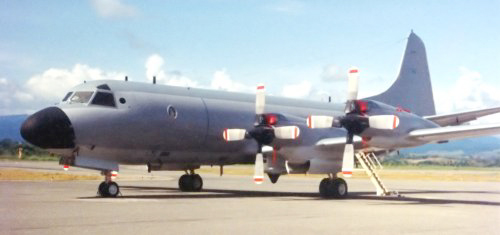
A9-665
in the experimental three tone grey scheme.
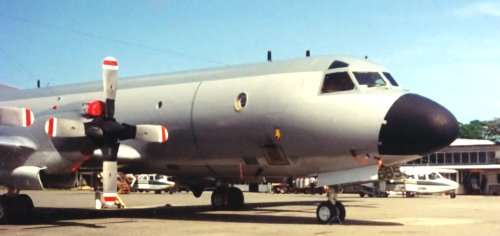
A9-665
in the experimental three tone grey scheme.
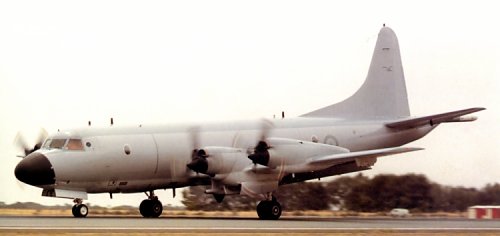
A9-665
in the experimental three tone grey scheme.

A9-665
in the experimental three tone grey scheme.
This scheme had been tested previously on Dakota A65-78 using
conventionally pigmented coatings but the tests were abandoned
because of excessive cabin temperatures.
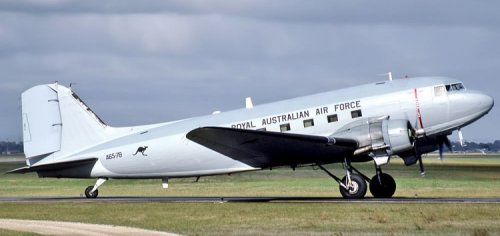
The
experimental three tone grey scheme was tested on Dakota A65-78.
On 13 February 1992, two Orions were parked together at Edinburgh
and instrumented to evaluate the new scheme which was known as
Solar Heat Reflecting - Low Visibility Paint Scheme (SHF-LVPS).
A9-665 in the new scheme was compared with A9-659 in the current
grey and white scheme which, by this time, had adopted low visibility
markings. The tests concluded that:
"The magnitude of the operational temperature increase under
the most severe conditions of low altitude in a hot/humid environment
is calculated to be 0.30C in the cabin and 1.30C at the flight
stations. Under less severe conditions, temperatures in the cabin
and the flight station will be controlled to current levels by
the ECS."
It was also concluded that the effectiveness of the camouflage
could be improved by eliminating the masked demarcation between
the mid and light shades.
As a result of the tests, in April 1993, a second Orion (unidentified)
was painted overall Light Grey FS36375 with markings in Pale Grey
FS36495 (i.e. lighter than the overall shade). It seems that this
scheme is close to what was eventually adopted across the fleet
although ultimately the markings were darker than the overall
shade.
A similar overall grey scheme applied to USN Orions and commonly
known as Tactical Paint, is said to have radar absorption properties
but it is not known if the RAAF paint has similar capabilities.
With only two of the surviving nineteen P-3Cs having the ELINT
capability, it is surmised that it was deemed tactically advantageous
for their presence to be disguised. The apparent solution was
to make all nineteen Orions look the same and ultimately all aircraft
were painted overall semi-gloss (also described as satin finish)
Light Ghost Grey (FS26375) with the roundels and other markings
presented in the darker shade of semi-gloss Grey Blue (FS25237).
Wheel wells, undercarriage legs, wheels and flight control recesses
were painted in gloss Insignia White (FS17875). This new livery
began to appear sometime around March 1995. To complete the ruse,
external serial numbers were effectively made invisible from "spotting"
distances. Squadron markings were retained but these were also
in Grey Blue such that they were barely visible. By this time
squadron markings were largely notional as all the Orions were
pooled under No 92 Wing at RAAF Edinburgh.
THE
FINAL SCHEME
1995 Onwards
| Light
Ghost Grey |
FS26375
|
9598A1
|
Overall
including radome. |
| Grey
Blue |
FS25237
|
67757E
|
Contrasting
markings |
| Insignia
White |
FS17875
|
EDF2F8
|
Wheel
wells, u/c legs, wheels and flight control recesses |
|
Propeller tips were black. |
| Shades
shown above are HEX approximations. |
| First
digit of FS spec indicates type of finish: |
| 1 = Gloss |
| 2 = Semi-Gloss |
| 3 = Matt |
While
the removal of external markings achieved the goal of making all
the Orions look the same, it wasn't much help to ground crews
who needed to tell one aeroplane from another when there were
multiple Orions on the apron. Clearly it would not do to load
an aeroplane with depth charges when the mission required droppable
life rafts and vice versa! It is reported that the need for external
identification was highlighted when a crew preflighted the wrong
aeroplane. Accordingly, the Orions were identified on the ground
in several ways:
Serial numbers were presented in grey or black on the white inner
face of the nose landing gear doors. Photographs suggest that
the 10 Squadron aircraft (700 series serials) showed the last
two digits of the serial number while 11 Squadron aircraft (600
series serials) showed the last three. Ultimately however, both
squadrons showed all three digits. Because the inside of the door
has a contoured surface, these numbers are sometimes difficult
to read (and probably even more difficult to apply!). As another
means of identification, the last three digits of the serial number
were presented in black on a dayglo orange "Remove Before
Flight" sleeve which was placed over the port nose landing
gear door while the aircraft was on the ground..
|
| |
|
|
| From
this distance the barely visible orange sleeve on the NLG
door is the only means of identifying A9-664. This picture
shows to advantage the semi-gloss satin finish. |
|
| |
|
|
|
This
image of A9-664 shows the two serial locations on the
NLG doors.
|
|
|
|
|
|
|
This image of A9-659 shows the location of the last three
digits of the serial number inside the NLG doors. In this
case the numbers appear to be in black.
|
|
|
For the benefit of
personnel boarding the aircraft, the full serial was presented
aft of the main cabin door in very small dark grey characters,
mostly in a horizontal format but in some instances the serial
was presented vertically.
|
|
|
|
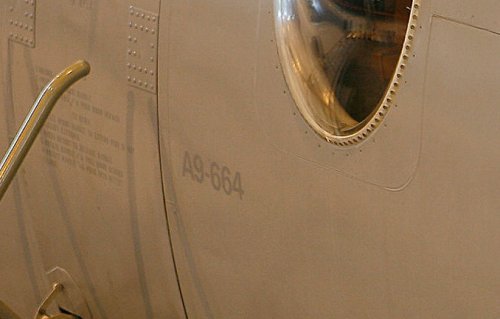
|
|
This
image of A9-664 shows the location of the serial number
aft of the cabin door.
|
|
|
|
|
|
|
This
image of A9-661 shows the vertical presentation of the
serial number aft of the cabin door.
|
|
|
Undoubtedly the serial
number would have been displayed in numerous locations inside
the aircraft but one known location is a placard on the captain's
instrument panel. Curiously, these placards displayed the serial
number with a leading zero e.g. A09-757 as seen in the following
image. These placards also carried the aircraft's SELCAL code
(i.e. Selective Calling - a means of calling an individual aircraft).
|
|
|
|
|
|
This
image shows the instrument panel placard on A9-757.
|
|
| |
|
|
|
The
low visibility 10 Sqn chimera on the tail of A9-756.
|
|
THE
AP-3C CONVERSION
July 2002 to December 2004
From July 2002 onwards, seventeen P-3Cs were given a major systems
upgrade after which they became known as the AP-3C (A = Australia).
The prototype (A9-760) was converted in the United States between
October 1997 and July 2002. (A9-754 was earlier written-off
and A9-663 was not converted). One noticeable feature of this
update was the elimination of the ALQ-78 ESM (Electronic Support
Measures) pod which had been mounted on a pylon under the wing
inboard of the #2 engine. The final conversion was completed
in December 2004.
|
Having
gone to all this trouble to de-identify the Orions, it complicated
matters for crews who wished to observe the time honoured tradition
of naming their aircraft. This was particularly so when Orions were
deployed to the Middle East Area of Operations in 2003. Evidently
the crews were allowed some latitude as colourful nose art began
to appear on the Orions. Perhaps it had been agreed that this was
permissible in theatre but still there were bizarre methods of maintaining
the subterfuge while giving aeroplanes individual names. Several
of the Orions were given female names (e.g. Hollie, Brooke, Nicky
etc) although it is not known if there was an underlying theme or
if the names were chosen randomly. Certainly the crews took it very
seriously as the aeroplanes were formally Christened by the Task
Group Padre! For these naming ceremonies, the aircraft carried their
individual names on a removable sleeve or banner which was placed
on one of the nose landing gear doors. It is not known if the aircraft
were permanently branded although the photograph above indicates
that the instrument panel of A9-757 was marked with the name Tina.
At other times prior to the conflict in the MEAO, RAAF Orions routinely
carried nose art and tail art to mark various anniversaries as well
as the annual Fincastle competitions. The following table attempts
to record Orion names and artwork although it does not pretend to
be comprehensive. Additions and corrections will be most welcome.
With the Orions now being withdrawn from service, and with delays
to the Gulfstream G550 project, it has been announced that the two
AP-3C(EW) ELINT Orions will be required to soldier on until 2023.
Ironically, all of the preceding subterfuge would then come down
to a requirement to hide two aeroplanes in a fleet of two! |
| |
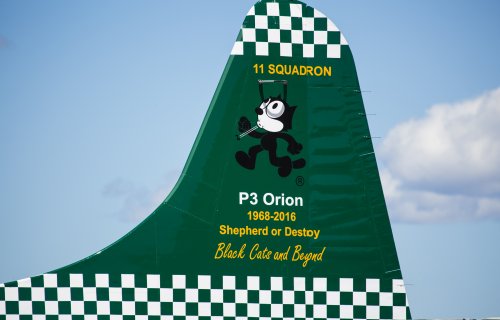
Tail
Art on AP-3C A9-664
|
AP-3C
ORION NAMES AND ARTWORK
|
|
SERIAL
|
NAME
|
REMARKS
|
|
A9-751
|
|
Noted
in MEAO with "That's Gold" nose art.
In 2014 carried nose art to mark the 75th anniversary of 10 SQN
and 11SQN. |
|
A9-752
|
|
|
|
A9-753
|
|
|
|
A9-754
|
|
|
|
A9-755
|
LADY
KINGSLAND |
In
JUN10 carried Felix nose art with caption "On Station Since
1939".
Name LADY KINGSLAND on NLG door sleeve for naming ceremony. (Lady
Kingsland was wife of wartime CO) |
|
A9-756
|
|
In
1985 carried a rainbow zap on the dorsal fin applied by Patrol Wing
2 at Barbers Point, Hawaii during Exercise SILENT PEARL.
In 1996 carried RAAF 75th anniversary nose art.
In 1997 carried Fincastle nose art.
In 2009 carried tail art and nose art to mark the 70th anniversary
of 10 SQN.
In 2014 carried nose art to mark the 75th anniversary of 10 SQN
and 11SQN. |
|
A9-757
|
TINA |
In
1999 carried tail art on blue tail for 60th anniversary of 10 SQN.
In 2008 carried Fincastle nose art.
In APR08 name "Tina" was handwritten on instrument panel
near callsign placard. |
|
A9-758
|
|
|
|
A9-759
|
|
In
1985 carried a rainbow zap on the dorsal fin applied by Patrol Wing
2 at Barbers Point, Hawaii during Exercise SILENT PEARL.
In 2002 carried AP-3C titles.
In AUG11 carried nose art "20,000 Operational Hours" |
|
A9-760
|
BROOKE |
In
1984 carried 492 SQN tail markings.
In 1996 carried RAAF 75th anniversary nose art, apparently only
on the LHS.
In 2002 carried AP-3C titles.
Name BROOKE on NLG sleeve for naming ceremony. |
|
|
|
A9-656
|
HOLLIE
(MAR08)
MIRANDA (APR09)
PATIENCE (2009)
|
In
1996 carried RAAF 75th anniversary nose art, apparently only on
the LHS.
In 2002 carried AP-3C titles.
In MAR08 carried nose art of Ten and Ace of spades with name HOLLIE
incorporated in artwork. See similar nose art on NICKY
. Name HOLLIE on NLG door sleeve for naming ceremony.
In JUN08 carried nose art of Ten and Ace of spades with caption
"That's How We Roll Them".
In APR09 carried nose art of a bikini clad lady (Patience?) holding
a telescope. |
|
A9-657
|
|
In
1985 carried "First Palmdale Built P-3C" on upper fuselage
stbd only.
In 1997 carried Fincastle nose art. |
|
A9-658
|
|
|
|
A9-659
|
|
In 1994 carried Fincastle nose art.
In 1996 carried RAAF 75th anniversary nose art, apparently only
on the LHS.
In 2002 carried AP-3C titles. |
|
A9-660
|
|
|
|
A9-661
|
NICKY |
In
1988 carried Australian Bicentennial logo on tail for Fincastle
competition.
In MAR08 carried nose art of
Ten & Ace of spades with the name NICKY incorporated in the
artwork. (Source: Air Force News 09JUL09) Name NICKY on NLG door
sleeve for naming ceremony. |
|
A9-662
|
|
In
SEP09 carried tail art commemorating 11Sqn 1939/2009.
In 2015 carried tail art of black & white checked bands on a
green tail with Felix character (same as 664) |
|
A9-663
|
|
|
|
A9-664
|
|
In NOV08 carried nose art of Sonic the Hedgehog with caption "That's
How We Roll!"
In OCT14 carried nose art for 10/11 Sqn 75th Anniversary.
In 2015 carried tail art of black & white checked bands on a
green tail with Felix character (same as 662) |
|
A9-665
|
|
Painted
in an experimental three tone grey scheme in 1992. |
|
UNASSIGNED
NAMES / NOSE ART
|
| |
HOLLYWOOD |
Name
on NLG door sleeve for naming ceremony. |
|
MOLLY |
Name
on NLG door sleeve for naming ceremony. |
| |
STEPHANIE |
Name
on NLG door sleeve for naming ceremony. Named after Australian Olympic
swimmer Stephanie Rice. (Source: Air Force News 13NOV08) |
|
LAURA |
"That's
How We Roll" |
|
JENNIFER |
Nose
art of a lady in a swimsuit (2005) |
|
SEA
DRAGON |
Nose
art in FEB14 (Winner of a competition for the Clipsal 500 motor
race) |
|
- |
Nose
art for Fincastle 1998 "Team Australia 1 In All In" |
|
- |
Nose
art for Fincastle 1993 "The Colonials" |
|
- |
Nose
art of a blonde girl kneeling (FEB11) |
|
ORION
ART
|
|
|
|
A9-756
- TAIL
10SQN
70TH ANNIVERSARY
|
A9-756
- NOSE
10SQN
70TH ANNIVERSARY
|
|
|
|
A9-756
75TH
ANNIVERSARY 10/11 SQNS
|
|
|
|
|
|
A9-756
PATROL WING 2 RAINBOW ZAP
|
A9-759
PATROL WING 2 RAINBOW ZAP
|
|
|
|
|
A9-760
75TH
ANNIVERSARY OF RAAF
|
A9-759
20,000
OPERATIONAL HOURS MEAO
|
|
|
|
|
A9-756
FINCASTLE
1997
|
A9-664
THAT'S
HOW WE ROLL
|
|
|
|
|
A9-760
BROOKE
|
A9-656
HOLLIE
|
|
|
|
|
A9-?
HOLLYWOOD
|
A9-?
JENNIFER
|
|
|
|
|
A9-656
MIRANDA
|
A9-?
STEPHANIE
|
|
|
|
|
A9-661
NICKY
|
A9-?
SEA
DRAGON
|
|
|
ORION
NAMES
IN THE MIDDLE EAST AREA OF OPERATIONS
by
Glen Bridger
I was on Rotation
1 in 2003, deployed as an ATECH on the Maintenance Crew. The
first aircraft had three “groundies”, and I flew in with one
other AVTECH on the second P-3. I was the first SNCO Groundy
in country. The remaining Maintenance Crew were delayed and
arrived about five days later.
We had been given very strict protocols as to what we could
say over the radios, and one day very early on, Groundies
being Groundies, decided to have some fun and named the two
aircraft Bill and Ben after the Flowerpot
Men. The flying program board in the Flight Line hut,
was annotated accordingly, and each aircraft had a white sticky
label placed on the LH and RH Forward Instrument Panels. Only
maintenance guys and girls used these names.
During one night shift, the AVTECHs were conducting radio
maintenance and did many radio calls between aircraft and
the flight line, “Bill this is Ben”, “Ben this Bill” etc etc.
After a few hours of this, the OC came over to the flight
line to tell the boys to stop “mucking around”. We told him
that they were legit radio calls and explained that we had
named the aircraft as a bit of fun to confuse anyone listening.
He had a chuckle and told us that the “spooks” were listening
in and couldn’t begin to understand what we were talking about.
When we said we would use correct radio calls, he said; "No,
keep 'em guessing."
The naming protocol continued for the entire MEAO Deployment
and as far as I know, the Groundies were the ones that came
up with the names as soon as the aircraft landed in country.
It may have ended up as a serious, formal event, and may have
been seen to be based on old war time traditions, but
it definitely started out as a bit of fun.
There is no known
listing of all the names and it is possible that names were
reused as aircraft rotated through the MEAO.
|
|
FOR THE LAST
TIME
|
|
|
|
A9-757 stripped and awaiting a new coat of paint at
the Air New Zealand paintshop in Christchurch on 6 July
2013.
|
|
Following the closure of the RAAF's Corrosion Control Facility
at Richmond in 2009, it became necessary for the Orions to be
painted by outside contractors. Accordingly, in 2012 a contract
was let to Boeing Defence Australia for thirteen Orions to be
stripped and repainted. Boeing partnered with Air New Zealand
Engineering Services for the work to be performed in Christchurch,
New Zealand. It was reported that this would be the last time
the Orions would require repainting before they were replaced
by the Boeing P-8A Poseidon. (Source: 5)
The first aircraft (A9-662) arrived in Christchurch on 17 May
2012 and departed on 15 June. The other aircraft were cycled
through the Christchurch facility with each repaint taking approximately
thirty days. The final aircraft (A9-751) departed Christchurch
on 16 June 2014 as "AUSY 217" direct to Edinburgh,
SA.
That this contract should be for 13 aircraft is curious because
by this time the RAAF still had 16 Orions on strength. Of the
original 20 P-3Cs, A9-754 had been lost at Cocos Island in 1991
and A9-755, 758 and 663 had been withdrawn from service and
scrapped in 2014. The following table lists 12 Orions that were
observed going through the Christchurch paint shop (Note: one
aircraft is missing). This leaves 4 aircraft, A9-756, 759, 657
and 660. It is surmised that it may have been deemed prudent
to have the two AP-3C(EW) ELINT aircraft (657 and 660) painted
elsewhere, if indeed they required repainting. This leaves A9-756
and 759 and the conclusion that one was painted and one wasn't.
A recent comparison of both aircraft suggests that A9-756 was
repainted and A9-759 was not. (See photo) |
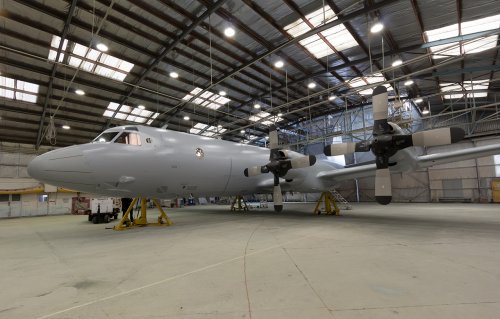
|
A9-656
in Christchurch on 13 September 2012 after being repainted.
(Picture: Peter Ede)
|
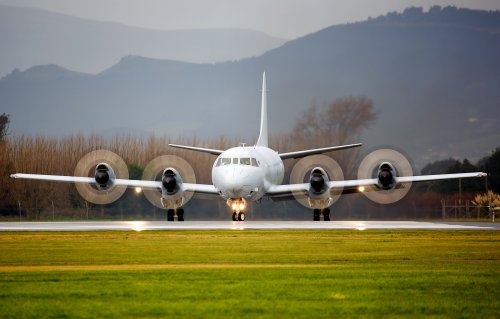
| A9-751
departing Christchurch on 16 June 2014 after being repainted
by Air New Zealand. (Picture: Matt Hayes) |
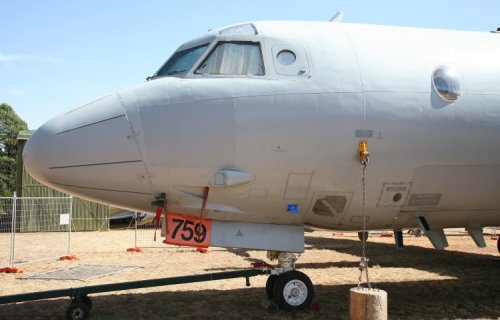
| A9-759
photographed in storage at Parkes, NSW in April 2018. The patch
of fresh paint on the nose appears to be covering artwork that
was carried by A9-759 in 2011. This would seem to indicate that
A9-759 was not repainted with the others in 2012-2014. A9-756,
which is displayed at the South Australian Aviation Museum,
has a superior finish which suggests that A9-756 was repainted
in Christchurch and A9-759 was not. (Picture: HARS) |
|
THE
FINAL REPAINT
|
|
#
|
AIRCRAFT
|
ARR
CHC
|
DEP
CHC
|
|
1
|
A9-662
|
17MAY12
|
15JUN12
|
|
2
|
A9-656
|
15AUG12
|
21SEP12
|
|
3
|
A9-664
|
16NOV12
|
18DEC12
|
|
4
|
A9-752
|
01FEB13
|
04MAR13
|
|
5
|
A9-661
|
XXMAR13
|
10APR13
|
|
6
|
A9-753
|
27APR13
|
28MAY13
|
|
7
|
A9-757
|
23JUN13
|
XXJUL13
|
|
8
|
A9-658
|
19OCT13
|
15NOV13
|
|
9
|
A9-665
|
14NOV13
|
15DEC13
|
|
10
|
A9-659
|
14DEC13
|
04FEB14
|
|
11
|
A9-760
|
16APR14
|
18MAY14
|
|
12
|
A9-751
|
16MAY14
|
16JUN14
|
|
13
|
A9-756?
|
?
|
?
|
|
|
Please
Advise Additions & Corrections
|
SOURCES
|
|
1
|
L.V.
Wake, "Development and Evaluation of a Near Infrared Reflecting
and Low Visibility Paint Scheme for RAAF P-3C Orion Aircraft",
DSTO, October 1993 |
|
2
|
Official
Monogram US Navy and Marine Corps Aircraft Color Guide Vol.
4 1960-1993. |
|
3
|
David
Reade, "The Age of Orion", Schiffer, 1998 |
|
4
|
Mike
Condon http://mrcaviation.blogspot.com.au/2014/06/raaf-orion.html |
|
5
|
Air
Force News, 31 July 2014 |
|
6
|
Ian
Pearson, Cold War Warriors, Big Sky Publishing, 2021 |
| Issue |
Date |
Remarks |
| 15 |
30JUN23 |
Added
an explanation of the names allocated
to Orions in the MEAO thanks to Glen Bridger.
Added an image of The Flying Porcupines nose art
carried by A9-756 for the 70th anniversary of 10SQN.
|
| 14 |
27OCT21 |
Revised
the date of introduction of toned-down markings to April
1989 when it is believed that A9-756 was the first P-3C
to be so painted. (Source: 6 p.352)
|
| 13 |
07DEC18 |
Added
another photo of A9-665 in the
experimental scheme. Also added a photo of Douglas C-47
A65-78 which was used to test
the experimental scheme. Thanks to Nigel Daw and Daniel
Tanner.
|
| 12 |
12AUG18 |
Added
A9-656 to the aircraft known to have carried RAAF 75th Anniversary
nose art in 1996. Apparently this was carried only on the
left hand side.
|
| 11 |
07AUG18 |
Added
two images of A9-665 in the experimental three tone grey
scheme thanks to Maurice Ritchie.
|
| 10 |
11MAY18 |
Added
images of the Patrol Wing 2 rainbow zap markings applied
to A9-756 and A9-759 during SILENT PEARL in 1985 thanks
to Leigh Collins and Ian Pearson.
|
| 9 |
20APR18 |
The
section For The Last Time on the last repaint has
been updated.
|
| 8 |
09APR18 |
The
section on P-3B markings has been revised thanks to input
from Peter Gilvarry.
|
| 7 |
05APR18 |
Added
a section For The Last Time on the last repaint.
Also added a reference to red flaps.
|
| 6 |
31MAR18 |
Added
a gallery of images of nose and tail art. Please note that
high resolution images are rarely available.
|
| 5 |
20MAR18 |
Major
revision to the section on the all grey scheme from sources
shown in table above.
|
| 4 |
10MAR18 |
Further
revision to the section on the interim scheme and the introduction
of the all grey scheme.
|
| 3 |
08MAR18 |
Revised
the section on the interim scheme on the basis of new evidence.
|
| 2 |
08MAR18 |
Added
"Hollywood" to list of unassigned names.
|
| 1 |
08MAR18 |
Original
issue.
|
|
|
|
|
Return
to the Lockheed File
|
|
|
|

